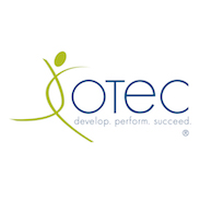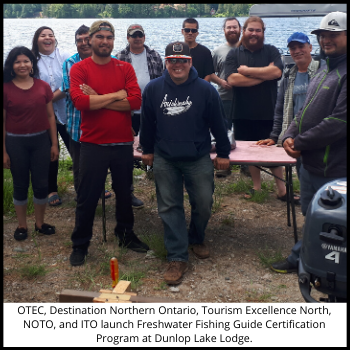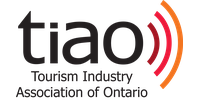
We’re featuring a special TIAO Member each month to share with the #TourismFamily what they do, and how they connect with TIAO. Learn something new about your tourism industry colleagues, and the value of a TIAO Membership!
Member of the Month: OTEC (Ontario Tourism Education Corporation)
This month we spoke with Adam Morrison, President & CEO at OTEC. Adam has spent over 10 years with OTEC and recently began in his new position as President & CEO in January 2020. Although known for its training programs and certifications, OTEC is much more than that. Read on to discover OTEC’s bigger vision.
Please note that this interview has been edited for clarity.
Tell us about your organization and its role within Ontario’s tourism industry.


“While OTEC’s work with destinations and corporate partners may get more attention, a lot of the work that we do is at the local level to engage and coordinate with small and mid-size businesses, and to try and establish the kinds of economies of scale at the local level that provide the capacity for these businesses that some of our largest corporate partners have. When we talk about workforce development best practices [such as becoming an employer of choice and engaging new labour pools] we often find that the news cycles are dominated by some of Canada’s largest corporate success stories and we try to bring those opportunities to the local level as much as we can. We find ourselves advocating more and more for what small business can do and really raising the profile of this sector, because there are a lot of really great employers of all sizes that are trying to do everything they can to ensure that tourism and hospitality is recognized as a destination for employment. But we need to help them more; we need to help them get the word out, and we need to build the capacity to enable them to do so – that’s a big priority for us moving forward.”
How long have you been a TIAO Member and why did you join?
OTEC has been a TIAO Member since 2011 and touts its TIAO Membership to the opportunity to further build its partnerships.
How has being a member of TIAO provided value for your organization?
“TIAO’s advocacy on the issue of tourism and labour and skills shortages helps put the spotlight on the need for strategic workforce development for the sector.”
“When we worked with TIAO in 2011 on the Ontario Tourism Workforce Development Strategy 2012-17, that was a key moment because the labour and skills shortages hadn’t really impacted our competitiveness yet. We were relatively proactive in that we could see the way that the industry growth was projected and we were one of the first sectors to get ahead of things and realize that this was going to be a major issue. We raised the issue and we developed a fantastic strategy with TIAO. And sure enough, towards the latter part of that planning period, the issue was hitting our major destinations in a big way. It was originally something that our more Northern and remote markets were feeling acutely, but when we did the last update to the labour supply and demand forecast in 2015, that’s when I heard businesses in places like Niagara, Toronto, and Ottawa, saying that they were now in the most critical labour and skills shortage levels on record. So that was when we started working to convene partners in a new provincial framework for tourism workforce development. We began working to develop what is now known as Tourism SkillsNet Ontario (TSO), which provides strategic insight, carries the message to the industry, and collaborates both on the development and execution of communication activities and strategy at large.”
What’s your favourite thing about TIAO and why?
Adam pointed to TIAO’s ability to be the bridge for connections as his favourite thing about TIAO.
“We find TIAO to be well connected at all levels of the industry – from the provincial, to the regional, to the municipal, and even to the business stakeholder. TIAO is able to bridge the official strategy work and validated research activities, but there’s also the grassroots – TIAO is able to bridge both worlds. We also appreciate TIAO’s daily willingness to pick up the phone and connect us to people in organizations that may want to get involved in workforce strategy.”
What are you working on right now?

“Traditionally we have been looking at labour market development or addressing labour skills shortages as a numbers game in terms of how many people we can attract and employ; it’s much more than that – it’s a systems issue, it’s complicated and it involves communications in terms of telling the story of why our industry is a destination for employment. It’s about capacity building – it means at a regional level how are our organizations working together with consistency, clarity, and clearly established workplans? It’s at the business level – how are businesses being empowered to become employers of choice? What are the success stories? How do we track progress? We really are a broad reaching sector and as we better understand the importance of tourism and hospitality at a market level, we’ll be able to tell a much better story on why it’s worthy of investment.”
Collaboration is Key
“In 2017 we began renewing Ontario’s workforce strategy, it included a new phase of provincial research and consultation undertaken with partners like TIAO, ORHMA, RTO’s, DMO’s, and municipalities. If anything is going to be sustainable, we need to provide the capacity at the destination level for our partners to be able to adapt the provincial strategy to their local needs, and to attract & sustain the investment needed to carry them out.”
Tourism SkillsNet Ontario is focused on five key deliverables: identify a sector partnership intermediary (a “lead organization”) in each region; coordinate funding opportunities to maximize sectoral investments; enhance employer engagement with existing pre-employment skills training programs; build awareness of industry realities and career paths; and facilitate access and distribution of sector specific labour market information.

“Each of those sets of activities also involves fairly unique sets of stakeholders and partners. In some cases, it’s the academic sector, or economic development, or even the employment training system, which is an entire industry in itself, with resources, expertise, funding, and partnerships that even fall outside of our own. From our perspective you’re only really operating in a strategic way if you’ve engaged all sets of partnerships, networks, and resources in one consistent plan that has mobilized all levels of stakeholders [municipalities, economic development, infrastructure, RTO’s, and DMO’s] – that’s really the work that Tourism SkillsNet Ontario is trying to do. It’s often said that there isn’t enough funding or enough resources, but when these various types of actors collaborate and share resources, reduce duplication, demonstrate commitment, and sign on in a well-coordinated role-and-function model that leverages all their strengths - that’s when we realize we actually have an incredible amount of resources and expertise at our disposal - we just have to mobilize it.”
What’s OTEC’s Vision for the Future?
“The vision for OTEC in the future is to continue to convene, coordinate and scale our efforts to address labour and skills shortages. Tourism SkillsNet Ontario has expanded to 12 destinations and we have plans to expand to 20 destinations by 2021. As we do that we see incredible opportunities to share resources, best practices, and communications collateral between the regions. I would say that the past two years have been about building up the local capacity in each destination, and moving forward we are excited to work with partners like TIAO to start bridging those destinations. Embracing and leveraging emerging technologies and providing access to new resources across the sector will be an important part of our strategy moving forward. This will allow us to create economies of scale and capacity as a sector that we have not seen in the past. The vision is also to have a cascading communications strategy so that the message can be carried from a provincial association like TIAO right down to the RTO’s and communities. This will ensure that our voice does resonate far beyond the local networks that we work with every day.”
If you had to give a piece of advice to another organization as to why they should get involved in advocacy initiatives, what would you recommend?
“I would say don’t go about it in isolation. The more that our messaging echoes with consistency, the more clear that message will be. Confusion is our enemy. If we can be consistent and take the time to reach the consensus so that we can speak in clear terms as a provincial network, we will benefit from clarity and we have strength as a network of advocates for the sector.”
Thank you to Adam for explaining OTEC’s role in the Ontario tourism industry, for sharing support for TIAO, and for being our member of the month for January!

